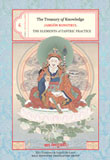
“Kongtrul describes the creation phase as a path based on the deliberate effort of thought. Its essential nature is the deity’s form, which represents inseparable appearance and emptiness. Its distinguishing feature is meditation whose steps correspond to birth, death, and the intermediate state, the three processes in cyclic existence. The completion phase is a nonconceptual path. Its essential nature is pristine awareness, made manifest when winds and mind have entered, abided in, and dissolved in the central channel.
The term ‘creation’ (bskyed), derived from the Sanskrit utpatti, denotes that which is created or fabricated by thought. ‘Phase’ (rim, krama) refers to a step or stage in the path, a ‘yoga.’ The phase of creation is also known as the phase of imagination, the fabricated yoga, or the conceptually created yoga. The term ‘completion’ (rdzogs), from the Sanskrit nispanna, means that which is ultimately true, the natural state, or the true nature. What is meant, Kongtrul explains, is a state with which one has to become familiar—not a new state of mind developed through practice, but one already fully present in the mind stream of every being: the pristine awareness of luminous clarity, the union of bliss and emptiness. The phase of completion is also called the nonconceptual yoga or the yoga of the natural state.
Kongtrul points out that an ordinary person ‘entangled in the net of discursive thinking’ would not be able to train in the completion phase, since it does not involve thoughts. Therefore, one first purifies the ordinary thought process by means of the yoga of creation, which entails the imagination of the deity and the mandala. Then, when one has understood the nature of thought, one embarks on the cultivation of the phase of completion. In other words, until the practitioner has given rise to an exceptionally stable realization of the natural state—the unfabricated completion phase—he or she must rely on the fabricated creation phase and employ imagination. Once realization has arisen, however, it is no longer necessary to deliberately cultivate ordinary types of creation-phase practices.”
—Ingrid McLeod and Elio Guarisco, from the Introduction to The Treasury of Knowledge: Book VIII, Part 3; The Elements of Tantric Practice, Jamgön Kongtrul



